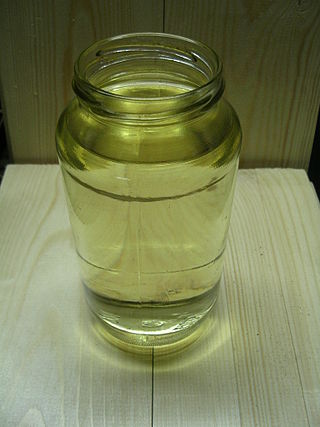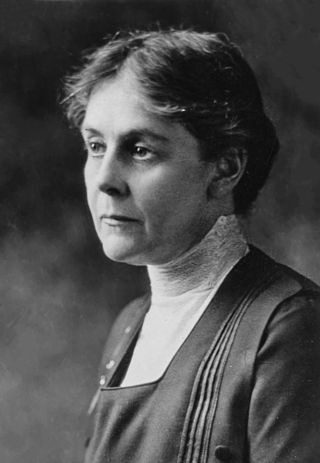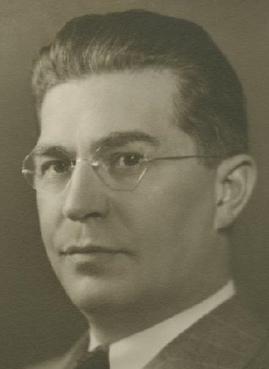Related Research Articles
The expression junk science is used to describe scientific data, research, or analysis considered by the person using the phrase to be spurious or fraudulent. The concept is often invoked in political and legal contexts where facts and scientific results have a great amount of weight in making a determination. It usually conveys a pejorative connotation that the research has been untowardly driven by political, ideological, financial, or otherwise unscientific motives.

Gasoline or petrol is a transparent, petroleum-derived flammable liquid that is used primarily as a fuel in most spark-ignited internal combustion engines. It consists mostly of organic compounds obtained by the fractional distillation of petroleum, enhanced with a variety of additives. On average, U.S. refineries produce, from a barrel of crude oil, about 19 to 20 gallons of gasoline; 11 to 13 gallons of distillate fuel ; and 3 to 4 gallons of jet fuel. The product ratio depends on the processing in an oil refinery and the crude oil assay. A barrel of oil is defined as holding 42 US gallons, which is about 159 liters or 35 imperial gallons.

Thomas Midgley Jr. was an American mechanical and chemical engineer. He played a major role in developing leaded gasoline and some of the first chlorofluorocarbons (CFCs), better known in the United States by the brand name Freon; both products were later banned from common use due to their harmful impact on human health and the environment. He was granted more than 100 patents over the course of his career. He contracted polio in 1940. In 1944 he was found strangled by a device he devised to allow him to get out of bed unassisted at his home in Worthington, Ohio. At the time, it was reported he was accidentally killed by his own invention. Privately, it was declared a suicide.

Tetraethyllead (commonly styled tetraethyl lead), abbreviated TEL, is an organolead compound with the formula Pb(C2H5)4. It is a fuel additive, first being mixed with gasoline beginning in the 1920s as a patented octane rating booster that allowed engine compression to be raised substantially. This in turn increased vehicle performance and fuel economy. TEL was first synthesised by German chemist Carl Jacob Löwig in 1853. American chemical engineer Thomas Midgley Jr., who was working for General Motors, was the first to discover its effectiveness as an antiknock agent in 1921, after spending several years attempting to find an additive that was both highly effective and inexpensive.

A catalytic converter is an exhaust emission control device that converts toxic gases and pollutants in exhaust gas from an internal combustion engine into less-toxic pollutants by catalyzing a redox reaction. Catalytic converters are usually used with internal combustion engines fueled by gasoline or diesel, including lean-burn engines, and sometimes on kerosene heaters and stoves.

Lead poisoning, also known as plumbism and saturnism, is a type of metal poisoning caused by lead in the body. The brain is the most sensitive. Symptoms may include abdominal pain, constipation, headaches, irritability, memory problems, infertility, and tingling in the hands and feet. It causes almost 10% of intellectual disability of otherwise unknown cause and can result in behavioral problems. Some of the effects are permanent. In severe cases, anemia, seizures, coma, or death may occur.
Vehicle emissions control is the study of reducing the emissions produced by motor vehicles, especially internal combustion engines.

Exhaust gas or flue gas is emitted as a result of the combustion of fuels such as natural gas, gasoline (petrol), diesel fuel, fuel oil, biodiesel blends, or coal. According to the type of engine, it is discharged into the atmosphere through an exhaust pipe, flue gas stack, or propelling nozzle. It often disperses downwind in a pattern called an exhaust plume.

2,4-Dinitrophenol (2,4-DNP or simply DNP) is an organic compound with the formula HOC6H3(NO2)2. It is a yellow, crystalline solid that has a sweet, musty odor. It sublimates, is volatile with steam, and is soluble in most organic solvents as well as aqueous alkaline solutions. When in a dry form, it is a high explosive and has an instantaneous explosion hazard. It is a precursor to other chemicals and is biochemically active, uncoupling oxidative phosphorylation from the electron transport chain in cells with mitochondria, by allowing hydrogen cations to pass from the intermembrane space into the mitochondrial matrix. Oxidative phosphorylation is a highly regulated step in aerobic respiration that is inhibited, among other factors, by normal cellular levels of ATP. Uncoupling it results in chemical energy from diet and energy stores such as triglycerides being wasted as heat with minimal regulation, leading to dangerously high body temperatures that may develop into heatstroke. Its use as a dieting aid has been identified with severe side-effects, including a number of deaths.

Alice Hamilton was an American physician, research scientist, and author. She was a leading expert in the field of occupational health and a pioneer in the field of industrial toxicology.

The Epidemic Intelligence Service (EIS) is a program of the U.S. Centers for Disease Control and Prevention (CDC). The modern EIS is a two-year, hands-on post-doctoral training program in epidemiology, with a focus on field work.

Herbert Leroy Needleman researched the neurodevelopmental damage caused by lead poisoning. He was a pediatrician, child psychiatrist, researcher and professor at the University of Pittsburgh, an elected member of the Institute of Medicine, and the founder of the Alliance to End Childhood Lead Poisoning. Dr. Needleman played a key role in securing some of the most significant environmental health protections achieved during the 20th century, which resulted in a fivefold reduction in the prevalence of lead poisoning among children in the United States by the early 1990s. Despite engendering strong resistance from lead-related industries, which made him the target of frequent attacks, Needleman persisted in campaigning to educate stakeholders, including parents and government panels, about the dangers of lead poisoning. Needleman has been credited with having played a key role in triggering environmental safety measures that have reduced average blood lead levels by an estimated 78 percent between 1976 and 1991. He died in Pittsburgh in 2017.
Jerome L. Silbergeld is an American scholar of Chinese art history. He has taught at Princeton University and the University of Washington.

Jonathan Livingston Seagull is the soundtrack album to the 1973 American film Jonathan Livingston Seagull, recorded by singer-songwriter Neil Diamond and produced by Tom Catalano. The album was released on Columbia Records, and grossed more than the film itself. It was Diamond's ninth studio album, and his first album after his successful 1972 live album Hot August Night. It won the 1974 Grammy as Best Original Score Written for a Motion Picture or a Television Special.

Thomas R. Frieden is an American infectious disease and public health physician. He serves as president and CEO of Resolve to Save Lives, a $225 million, five-year initiative to prevent epidemics and cardiovascular disease.
David Rosner is the Ronald H. Lauterstein Professor of Sociomedical Sciences and professor of history in the Graduate School of Arts and Sciences at Columbia University. He is also Co-Director of the Center for the History and Ethics of Public Health at Columbia's Mailman School of Public Health. He was elected to the National Academy of Sciences' Institute of Medicine in 2010.

Yandell Henderson was an American physiologist. The New York Times called him an "expert on gases" and "an authority on the physiology of respiration and circulation and on pharmacology and toxicology of gases". He was also noted for new methods in resuscitation. Henderson was a director of the Yale Laboratory of Applied Physiology at Yale University, a member of the National Academy of Sciences, chairman of the section of physiology and pathology of the American Medical Association. He was also a member of the American Philosophical Society. A collection of his papers are held at the National Library of Medicine in Bethesda, Maryland.

Robert Arthur Kehoe was an American toxicologist and a dominant figure in occupational health. Working on behalf of the lead industry, Kehoe was the most powerful medically-trained proponent for the use of tetraethyllead as an additive in gasoline.

The lead–crime hypothesis is a research area that involves a study of the correlation between elevated blood lead levels in children and increased rates of crime, delinquency, and recidivism later in life.

Mona Hanna-Attisha is a pediatrician, professor, and public health advocate whose research exposed the Flint water crisis. She is the author of the 2018 book What the Eyes Don't See, which The New York Times named as one of the 100 most notable books of the year.
References
- ↑ Silbergeld, Ellen (February 1995). "Annotation: Protection of the Public Interest, Allegations of Scientific Misconduct, and the Needleman Case". American Journal of Public Health. 85 (2): 165–166. doi:10.2105/AJPH.85.2.165. PMC 1615323 . PMID 7856774.
LIA's greatest triumph was in 1925, when it overrode opposition to the introduction of tetraethyl lead as a gasoline additive
- ↑ Rabin, Richard (2008). "The Lead Industry and Lead Water Pipes "A MODEST CAMPAIGN"". American Journal of Public Health. 98 (9): 1584–1592. doi:10.2105/AJPH.2007.113555. PMC 2509614 . PMID 18633098.
- ↑ Zhorov, Irina (February 29, 2016). "How We Ended Up With Lead Piping And Why Removing It Will Be Hard". WESA . Retrieved October 29, 2018.
- ↑ Silbergeld, Ellen (January 1996). "Silbergeld Responds". American Journal of Public Health. 86 (1): 115. doi:10.2105/ajph.86.1.115. PMC 1380383 . PMID 8561232.
Although the Lead Industries Association (LIA), which Smith directs, was not itself involved in these and other activities, its predecessor, the National Lead Institute, was active in obscuring the hazards of lead.
- ↑ Peter Reich (June 1992). The Hour of Lead (PDF) (Report). Environmental Defense Fund. p. 14. Retrieved December 19, 2019.
... National Lead Institute ... Apparently a predecessor of the Lead Industries Association.
- ↑ "Open Price Idea Grows". Paint, Oil and Drug Review. April 3, 1918. Retrieved December 19, 2019.
- ↑ Smith, Heather (June 22, 2018). "The Lead Poisoning in Flint Points to a Nationwide Problem". Sierra Club. Retrieved October 29, 2018.
- ↑ Newsline, Legal (November 14, 2017). "Lead Paint Makers Lose Another Round In Long-Running, $1.1 Billion California Lawsuit". Forbes. Retrieved October 29, 2018.
- ↑ Kitman, Jamie Lincoln (March 2, 2001). "The Secret History of Lead". The Nation. Retrieved October 30, 2019.
- ↑ Rogers, Jim (2004). Hot Commodities: How Anyone Can Invest Profitably in the World's Best Market . Random House Publishing Group. p. 170. ISBN 9781588364470.
- ↑ Smith, Gerald R. (2002). "Lead in April 2002" (PDF). USGS Mineral Industry Surveys. USGS. Archived from the original (PDF) on April 4, 2019. Retrieved April 4, 2019.
- ↑ "The World of Lead - The Lead Industries Association". Lead Info. 2002. Archived from the original on November 24, 2002. Retrieved October 31, 2019.
{{cite web}}: CS1 maint: unfit URL (link) - ↑ Schweiker, Richard (February 7, 1972). "Congressional Record -- Senate" (PDF). US Government Publish Office. pp. 2813–2817. Retrieved March 28, 2021.
My interest in this matter was stimulated further by a recent NBC television program, Chronolog," which did a special report on the hazards of lead to humans from these products.
- ↑ Cole, Jerome F. (February 10, 1972). "NBC Chronolog Program" (PDF). Toxic Docs . International Lead Zinc Research Organization. Retrieved March 28, 2021.
We went over the transcript page by page and I want to point out to you, just in general, the points which were brought up in our discussions and also the points you may want to use in backing up any argument with NBC.
- ↑ "Handwritten, proposed edits to script, undated" (PDF). Toxic Docs . Lead Industries Association. Retrieved March 28, 2021.
1. strike through lead attacks black.. .white... rich... poor and replace with the poor whether black or white; 2. strike through Lead fallout from industrial waste and auto exhausts; 3. strike through From polluted air and soil where exhaust fumes and industrial wastes have settled and replace with From their food and from the air but these are relatively unimportant compared to old paint
- ↑ Stevens, Ronald G. (July 28, 1972). "Letter to Jerome F. Smith" (PDF). Toxic Docs . Long Island Film Studios. Retrieved March 28, 2021.
The narration change that Dr.'s Harrison and Cole have agreed to, will require re-writing paragraph six in the present narration to eliminate the reference made to lead content in the auto exhausts that your Association feels is misleading
- ↑ Smith, Jerome F. (August 2, 1972). "Letter to Ronald G. Stevens" (PDF). Toxic Docs . Lead Industries Association. Retrieved March 28, 2021.
This is an excellent movie and with the proposed change in Paragraph 6—which will eliminate the reference to lead in automotive exhausts-—we think this film will find wide acceptance in the health field.
- ↑ Smith, Jerome F. (August 31, 1972). "Letter to Ronald G. Stevens" (PDF). Toxic Docs . Lead Industries Association. Retrieved March 28, 2021.
I regret that you cannot see your way clear to make the changes we suggested in your movie, "Lead Poisoning, The Hidden Epidemic."
- ↑ Stevens, Ronald G. (November 1, 1972). "Letter to Jerome F. Smith" (PDF). Toxic Docs . Long Island Film Studios. Retrieved March 28, 2021.
One of the overriding reasons we had to decline your offer was due to the objections of several National Health Organizations that had endorsed the film in its present version. ... One further comment regarding the film an Lead Poisoning--The Hidden Epidemic, we have just been awarded the New York International Film Festival's 1972 Silver Medal.
- ↑ Cole, Jerome F. (November 17, 1972). "Letter to Ronald G. Stevens" (PDF). Toxic Docs . Lead Industries Association. Retrieved March 28, 2021.
We were most surprised that you, with the advice of Dr. Dorothy Harrison would not accept our criticisms of the film and refused to make alterations which would have made the film such more effective. ... You have our congratulations for winning the 1972 Silver Medal, awarded from the New York International Film Festival.
- ↑ Smith, Jerome F. (May 10, 1973). "Promotional Brochure on Film About Lead Poisoning" (PDF). Toxic Docs . Lead Industries Association. Retrieved March 28, 2021.
About six Months ago, the Association was asked to review this film, which we did. In the main it was well done although it does contain one brief, misleading segment that attempts to establish a relationship between lead in the air due to automotive gasoline antiknocks and childhood lead poisoning.
- ↑ Canzler, Lillian (May 1, 1974). "Films and Filmstrips on Early Childhood" (PDF). Education Resources Information Center . Washington Center for Early Childhood Education. Retrieved March 28, 2021.
Lead Poisoning: The Hidden Epidemic - 10 min color